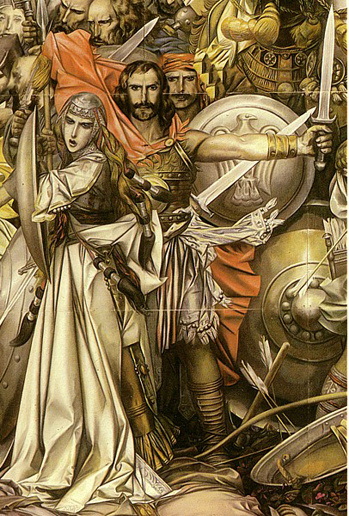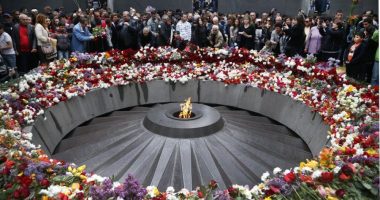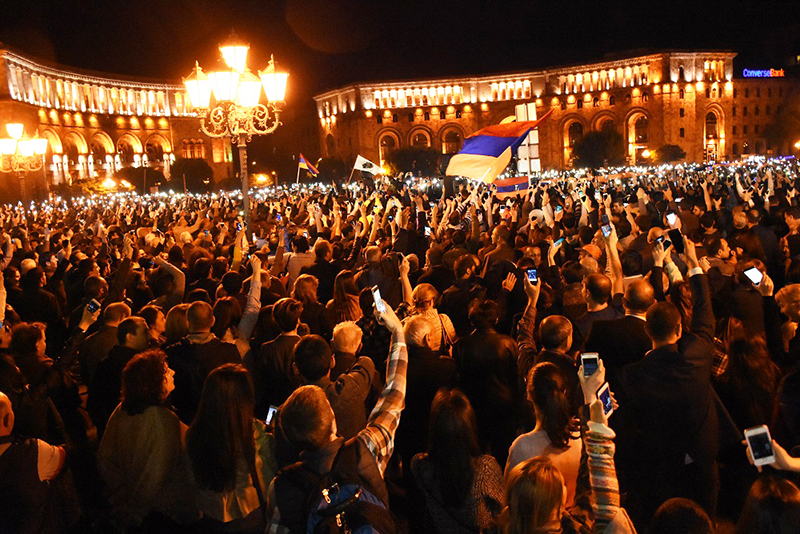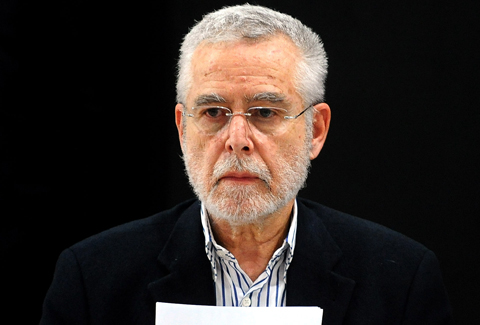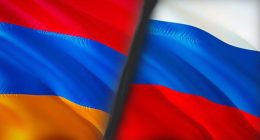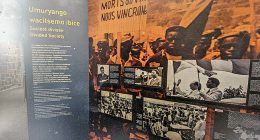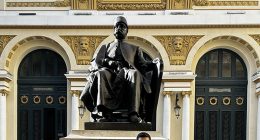White Paper on “Hayastan” All-Armenian Fund
Part III
When John Danilovich, Chief Executive Officer for the Millennium Challenge Corporation (MCC), warned Robert Kocharyan on March 11, 2008, that the program may suffer because of Armenia’s retreat from democracy—the March 1 crackdown, political prisoners—Robert Kocharyan, then the outgoing self-declared president of Armenia, replied that we would find other sources of money. This irresponsible statement is reminiscent of the King of France Louis XV (1710-1774), who is known to have said: “Après moi, le déluge” (After me, the deluge).
The Millennium Challenges made a decision to cut the aid. As a result, 943 km of rural roads were left unrepaired in 265 rural communities of Armenia, and an estimated 6% poverty reduction remained on paper. The MCC press release issued on March 11, 2009 reads: “The Board’s decision today signals to the government that it has failed over several years to address concerns raised not only by MCC and other U.S. Government agencies, but the international community as well.” Moreover, Armenia has been denied eligibility for a second compact, unlike its northern neighbor, Georgia. At its winter quarterly meeting on January 5, 2011, MCC chose Georgia and Ghana as eligible to apply for second compacts, which are “contingent on successful completion of first compacts and continued good policy performance” (Center For Global Development).
Who had bolstered up Robert Kocharyan’s confidence? Could it be that entities, such as the Lincy Foundation, “Hayastan” All-Armenian Fund, and other Armenian charitable organizations have contributed to the former self-declared president’s carelessness and arrogance, because of their leniency toward harrowing economic, political and social injustice in Armenia? “Hayastan” All-Armenian Fund presents itself as an apolitical entity, which takes care of common people, no matter who rules them and how. The irony of this is that a non-Armenian organization, such as Millennium Challenges Corporation, appears to care more about the rights of Armenian citizens than all the Armenian charitable organizations today.
The 20-year history of Armenia’s independence is full of tragic events and highly undemocratic decision-making by the state leadership—from the brutal crackdown following the rigged 1995 presidential elections to the murderous crackdown following the rigged 2008 presidential elections, including countless violations of human rights in between. However, not even once has the Fund been able to show its attitude toward state injustice because it is the state itself. It is its outright politicization—inclusion of representatives from the major Armenian political parties functioning in the Diaspora, along with the top Armenian and Artsakh officials—that paralyzes the Fund, making it numb to socio-economic disasters, which result in more need for charity.
Of all Board members, it was Louise Simone Manoogian, who eventually gave up her membership on the Board of Trustees in 2009, despite the efforts of top officials to keep her in the game. However, the leadership of the Board was in fact able to talk another member out of quitting. According to a former employee of the Fund, who spoke under the condition of anonymity, Bedros Terzian, another member of the Board of Trustees who was deeply disenchanted with Serzh Sargsyan because of the bloody March 1, 2008 events and wanted to quit, was persuaded to remain on the Board. The withdrawal of France, of which Terzian is a representative, would have been a painful loss for the Armenian government.
However, the government’s refusal to reform itself is inevitably going to lead to bigger losses. The recent news about the Lincy Foundation shutting down and not allocating any of its remaining assets to Armenia indicates a shift in the attitude of American-Armenian billionaire and philanthropist Kirk Kerkorian toward the Armenian authorities.
“A Lincy Foundation representative told the L.A. Times that UCLA was chosen as the recipient of the $200 million financial gift because the foundation has given the campus about $70 million in previous gifts and has been pleased with the way the money was used,” writes Hollywood Reporter.
According to a recent publication at 1in.am alluding to sources from within the government, the withdrawal of MCC from Armenia, shutdown of Lincy Foundation, as well as Armenian Prime Minister Tigran Sargsyan’s failure to attract funds from Russia, have caused a panic among the government officials who have begun admitting that Armenia’s economy is on the verge of collapse.
Part I and Part II previous parts of this white paper have shown that the main flaws of the Fund have, in fact, one common source: the government. Moreover, this is a problem squared, as there are two governments controlling the Fund: the Republics of Armenia and Artsakh. Part III explores other ways the government has been utilizing its unreserved control over “Hayastan” All-Armenian Fund, the reasons behind them, and the consequences.
The More Unpopular the Government, the Less Popular the Fund: Officials don’t let go of the Fund because its good performance is a shortcut to boosting their approval.
Judging from an open letter written in 1998 by a 63-year-old pensioner and addressed to Raffi Hovannisian, then the newly appointed Executive Director of “Hayastan” All-Armenian Fund, the Fund appears to have had a good start:
I’m 63 years old. I graduated from a university in Moscow, returned to Yerevan and worked for over 40 years in various planning institutes as a chief specialist. I have participated in the planning of many beautiful buildings of the city of Yerevan; and even now I feel proud looking at them. I used to be paid well and had a comfortable life. Now I am a pensioner, who gets a pension of 3,760 drams (not dollars) a month. Like many of my compatriots, I was robbed by my “own” state in broad daylight: I was deprived of my modest savings kept in the Savings Bank.
In 1992, “Hayastan” All-Armenian Fund was established. Our first president called on the people: “Each person should donate 1 gram of gold to the Fund for the sake of the prosperity of the free and independent homeland.” I gave not just 1 gram, but 6 grams of gold.
Like many of my compatriots, I was also disappointed with the president I had elected and the people that came to power. I became poor, endured the period of darkness, coldness and starvation. I lost many noble and honest young men related to me; I saw the new emigration of my people. I’ve seen and still see how multi-story private mansions of people—while no one knows how they became instantly rich—rise in the center of the city (and environs), including the mansion of Manushak Petrosyan, the former Executive Director of “Hayastan” All-Armenian Fund.
Now I’m learning from the newspapers that a large sum of money has been transferred to a number of personal bank accounts in Western Europe on behalf of Levon Ter-Petrosyan’s clan.
To Mr. Raffi Hovhannisian: As a citizen of the Republic of Armenia and a donor to the “Hayastan” All-Armenian Fund, I demand that you:
Make an investigation into this fact;
If this allegation is proven to be true, publicize the names of all the robbers without exception and launch criminal probes against them.
If none of this is done I demand (not request) that my donation of 6.086 grams of gold to the “Hayastan” All-Armenian Fund be returned. Attached is Receipt #1956 as proof the donation.
/signed/ Laura Barseghyan, citizen of the Republic of Armenia
P.S. To all the citizens who have donated to “Hayastan” All-Armenian Fund: if you are concerned about the fate of your donation, please, send the copy of your donation receipt to Iravunk Weekly, in care of Laura Barseghyan. (Iravunk Weekly)
This open letter shows what miracles mere trust can work. The author of the letter is an economically challenged pensioner, making a donation of 6 grams of gold (an amount about ten times her $7 monthly pension). It took as many as 12 years for at least one name—Robert Kocharyan—as the one responsible for extortions, to be publicized by Garin Hovannisian in connection to the allegations, to which she was referring in her letter (see Part I). It’s not known whether Mrs. Barseghyan was still alive to receive the partial answer to her request.
The open letter above clearly shows that often all it takes to enthuse large masses to donate for a good cause is a democratically elected statesman on the Board. But the rapid transition of Levon Ter-Petrosyan’s image of a national hero to that of a national evil in the mid-1990s, cost “Hayastan” All-Armenian Fund dearly. How have the authorities been making up for the trust vacuum that emerged in the mid-1990s?
More and more people in the Diaspora, Armenia and Artsakh have become reluctant to donate, because they don’t trust the government, which they identify with “Hayastan” All-Armenian Fund. If the leaders of both republics really cared about the fate of the Fund and its productivity, they would voluntarily resign from the Board of Trustees and the Presidium of the Board of Trustees and make sure that every public official and political party representative would do the same. However, they have been doing quite the opposite, because their goal is not so much the productivity of the Fund as it is its symbolic significance.
Throughout its existence, the “Hayastan” All-Armenian Fund has evolved into something more than a charity generator. Thanks to its large world-wide donor base and projects of national proportions, the Fund has grown to become a symbolic element uniting the peoples of Armenia, Artsakh and the Diaspora. And since the head of the Armenia also leads the Fund, the general public and the media tend to see a connection between the Fund’s annual fundraising figures and the government’s popularity.
Face-lifting “Hayastan” All-Armenian Fund: Officials force state employees to make donations to “Hayastan” All-Armenian Fund, inflate the real amount of donations, and use other strategies to compensate for the society’s trust crisis. As a result, the simulation of good performance creates an illusion of the government’s popularity.
Levon Ter-Petrosyan’s successors, Robert Kocharyan and Serzh Sargsyan, have used both external (Diaspora) and internal (Armenia and Artsakh) strategies to face-lift the Fund.
External Strategy
After becoming president of Armenia in 1998, Robert Kocharyan had the intention of winning over the hearts of Diaspora Armenians. He appointed American-Armenian Raffi Hovannisian as Executive Director of “Hayastan” All-Armenian Fund; lifted the ban on the activities of the Armenian Revolutionary Federation-Dashnaktsutyun (ARF-D) in Armenia; and, following his dubious reelection in 2003, formed a Government coalition with them. The latter two of the steps not only warmed the hearts of Diaspora Armenians toward the Armenian government, but also contributed to a positive propaganda for “Hayastan” All-Armenian Fund in the Diaspora, especially thanks to the enormous influence of ARF-D in the Armenian communities all over the world.
The new authorities needed a new ally, especially after seeing the latter’s teeth. As a reaction to its ban in 1995, ARF-D had already shown its teeth by boycotting of “Hayastan” All-Armenian Fund, as well as its weight in the Diaspora by being able to raise about $7 million in aid for Artsakh in 1995. (When I later asked Hovig Saliba, ARF Central Committee of Western United States, about the fate of the donations, including my own, he said it was used for the party’s needs. But that is a different topic).
Serzh Sargsyan predictably copied his predecessor’s strategic move by having ARF-D join a four-party coalition 20 days after the March 1 bloodshed in 2008. ARF-D denounced Serzh Sargsyan and quit the coalition only a year later on the symbolic date of April 24. The motivation for that act was the eminent signing of the Armenian-Turkish protocols, which, eventually, took place on October 10, 2009. There is no need to be a math-whizz to understand the logic—10 victims is a negligible number against 1.5 million.
One of the effective components of the authorities’ external strategy contributing to the formation of a favorable image of themselves and their initiatives, including “Hayastan” All-Armenian Fund, is the tendency of making accomplices out of their partners. Cooperation of certain entities with the authorities often implies sharing their responsibility not only for the shortcomings of a joint initiative, but for the mere fact of cooperation, due to the fact that the Armenian authorities have rigged the elections and are corrupt.
Despite the dissent on foreign policy matters, ARF-D has intertwined itself with the authorities too tightly for the past 10 years to become hostile toward them and sever all ties. A very recent incident with Los Angeles-based Asbarez Daily shows that the opposing views on foreign policy issues hasn’t had a negative impact on the Dashnaks’ treatment of “Hayastan” All-Armenian Fund. This friendly position present since Kocharyan’s rule has been most recently confirmed by the refusal to publish my comments (including links to Part I and Part II of this white paper) under an article about Sarkis Kotanjian’s interview mentioned above. My attempts to reach the editor-in-chief, requesting explanation, were left unanswered. A fragment from “Armenia-Diaspora Relations: 20 Years Since Independence,” a report issued in February 2010 by a Washington-based think tank Policy Forum Armenia (PFA), has an alternative interpretation of the nature of such interaction:
While many among the Diaspora live in democratic countries, democracy is seldom practiced in the Diaspora structures. This may at least partially explain why a sizeable number of Armenians have opted to remain outside the community organizations and become passive and silent members of the Diaspora. Dissent—both from inside and outside of the organizations—is suppressed and at times results in the sidelining of the whistleblowers. While partisan views are commonly rejected by most who stand on the other side of the line, independent positions are viewed with suspicion by all sides. (P. 23)
More recently, Nouvelle d’Arménie magazine in France displayed a similar behavior. After over 200 posts and about 5000 views in about 10 days, the entire thread titled “Toute la vérité sur le Fonds Pan-Arménien” (“The whole truth about the All-Armenian Fund”) in the magazine’s forum was deleted. The forum users were discussing the first two parts of this white paper. Ara Toranian, Editor of Nouvelles d’Arménie, had the following explanation: “À la demande du president du fonds arménien de France les messages estimés calomnieux des internautes HB et Shant Mamaz ont été supprimés du fil de discussion sur le Fonds arménien de France. La suppression du premier message entraînant automatiquement l’effacement du reste des messages dans notre logiciel, c’est toute la discussion qui a été supprimée.” (At the request of the president of the Armenian Fund in France, internauts HB and Shant Mamaz’s messages on “Hayastan” All-Armenian Fund being deemed defamatory were deleted from the forum thread. The deletion of the first message automatically resulted in the deletion of the rest of the posts in our software. The entire thread was deleted).
Ara Toranian’s explanation was disheartening for most of the forum users and has eventually turned into an ongoing forum discussion here. And the first message, to which Ara Toranian refers, was just a link to the Part I of this white paper republished at Hraparak, accompanied by the following words: “Dommage pour ceux qui ne lisent pas l’arménien!” (Too bad for those who do not read Armenian). Luckily, I had saved all 9 pages of the forum thread before its deletion. The recovered discussion (in French) can now be accessed here.
But the most curious point here is that it was Bedros Terzian who had complained about the forum discussions and ordered Mr. Toranian to remove the posts that supposedly defamed the “Hayastan” All-Armenian Fund. A person who three years ago wanted to quit the Fund now has to protect it by silencing open public discussion and criticism. Mr. Terzian eventually wrote a response published in Nouvelles d’Arménie, on February 22, 2011, which has turned out to be a very familiar emotionally charged reminder of all the life-saving projects carried out by the Fund within about 20 years of its existence. As if to say that all good deeds automatically bestow forgiveness for bad ones. At the same time, Mr. Terzian’s response fell a little short of the absolutism observed in Sarkis Kotanjian’s interview: outright refusal to admit any shortcomings past or present. He writes: “Mais nous essayons de faire de notre mieux et nos donateurs peuvent en être fiers. Le miracle, quand on y pense, ce n’est pas d’avoir commis des erreurs, mais d’en avoir commis si peu en dépit du contexte extrêmement difficile de ces années” (“We are not infallible. But we are trying to do our best, and our donors can be proud of that. The miracle, when one thinks about it, is of not having committed errors, but of having committed so few, in spite of the extremely difficult context of these years.”)
However, what was particularly glaring throughout Bedros Terzian’s response can be described thus—there is an elephant in the text. There is not a single reference to this white paper, the first two parts of which, in fact, had sparked the heated discussion resulting in his utmost indignation. Instead Mr. Terzian’s aims his tirade at the two forum users mentioned above—HB, who translated the entire first two parts of this white paper into French, posted them piece by piece and raised critical questions about the Fund, and Shant Mamaz, who was often quite vocal about the shortcomings of the Fund. The motives behind Mr. Terzian’s deliberate circumvention of the white paper and/or its author are not quite clear. However, judging from the information provided by a reliable anonymous source above, Bedros Terzian is practically doomed to defend the Fund.
Internal Strategy
The internal strategy of whitewashing “Hayastan” All-Armenian Fund in the eyes of people without first punishing those who squandered the All-Armenian riches, is a little more difficult task. The authorities have been doing what contradicts the very essence of a donation—they forced it (see Part II).
The presentation of pledges as donations has been an alternative strategy of inflating numbers. This circumstance is obviated by the record-breaking $35 million supposedly raised by “Hayastan” All-Armenan Fund during the Telethon-2008. This astonishing amount, reportedly raised in as few as 8 months after the bloody March 1 events, was interpreted by many in Armenia and Artsakh as a slap in their face; a clear statement of the Diaspora’s support for the illicit regime. However, by October 17, 2009, about a year after the 2008 Telethon, “Hayastan” All-Armenian Fund had reportedly been able to collect only about $10 million of the $35 million pledged. Subsequently, a well-informed former Fund insider said that no more than $7 million was collected that year, which was less than the past four years. This sum, of course, is a mild but more plausible reaction of “all Armenians” toward the March 1 bloodshed and what followed.
The same well-informed insider confirmed that some of the million-dollar donations are made on condition of getting a part of it back; at least a half.
The Board Maniac: “Hayastan” All-Armenian Fund as Victim of Serzh Sargsyan’s Board Addiction.
Apart from all the logical arguments, there is also a psychological reason why Serzh Sargsyan would not part from his post as the President of the Board of Trustees. As a self-appointed president, having developed a complex of an undesirable person in the country he rules, Serzh Sargsyan has made sure he is a fairly elected president of all kinds of boards of strategic importance in the Republic of Armenia. A die-hard collector of chairs, Serzh Sargsyan, President of “Hayastan” All-Armenian Fund, has recently been reelected President of the Board of the Yerevan State University, and President of the Chess Federation. In both cases, he was reelected with 100% of the votes—it appears no one dared think otherwise. These mini-elections are a source of consolation for someone who is constantly reminded of and blamed for rigging the presidential elections in 2008.
To further cement his total control over the country, Serzh Sargsyan has had two of his closest allies who hold key Government positions—Prime Minister Tigran Sargsyan and National Assembly Speaker Hovik Abrahamyan—follow his example and become presidents of the Boards of Yerevan State Pedagogical University and the Yerevan State Engineering University, respectively.
This ubiquitous presidency is also a veil for Serzh Sargsyan’s totalitarian intentions. In September of 2008, he used his alternative presidency to have four professors from the Yerevan State University fired due to their oppositional views—among them, prominent representatives of the civil society in Armenia, investigative journalist Edik Baghdasaryan, and film director Tigran Xmalyan (Khzmalyan).
Picking Up the Slack: Officials make “Hayastan” All-Armenian Fund fix or restore whatever an official or a crony has damaged or destroyed without being punished.
As long as there is “Hayastan” All-Armenian Fund, and the authorities have enough control to steer its funds in whatever direction they wish, public officials and their cronies can get away with pillaging infrastructures for their personal gains. Below, two persons are presented who have either wasted or destroyed what “Hayastan” All-Armenian Fund had to later restore at the expense of the good-will of donors. The continuing disastrous ascent of these persons is the consequence of not stopping them in time.
Grisha (Grigori) Harutiunyan
Back in 2002, Aravot was publishing a series of articles about the mansions erected in Armenia in the years following the collapse of the USSR. The articles were aimed at uncovering the owners of the villas and the financial sources used for their construction. One of the articles in the series about a fortress-like mansion in Bjni read: “No one has forgotten the scandal during the construction of the Military Academy.” The mansion in question belongs to Grisha Harutiunyan, one of the tycoons of Armenia’s shadow economy.
Becoming Armenia’s Minister of Defense in 1994, Serzh Sargsyan appointed Grisha Harutiunyan deputy Minister and entrusted him with supervising the construction of a military academy in Yerevan. The construction of the academy was sponsored by Diaspora Armenians. A year later, upon replacing Serzh Sargsyan as Minister of Defense, Vazgen Sargsyan decided to scrutinize construction papers. When he grasped the scale of the financial manipulations, he became so furious that, according to some Chorrord Inknishkhanutyun, he broke a chair on the builder’s head. Whereas Grisha Harutiunyan, deputy Minister of Defense, fled the room before another chair could land on his head.
Vazgen Sargsyan engaged “Hayastan” All-Armenian Fund to finish the construction of the Military Academy. Within three years, the Fund completed the construction of the 3rd, 9th, 4th and 7th buildings of the Academy, spending a total of over $2 million. According to the official website of the Fund, the sponsor for the 4th and 7th buildings of the Military Academy was the Izmirlian Foundation from Switzerland.
As for Grisha Harutiunyan, he was fired from the Defense Ministry, but instead of facing criminal charges, he was appointed deputy Minister of National Security. His boss was once again his patron, Serzh Sargsyan, who was now the Minister of National Security. Why wasn’t Grisha Harutiunyan prosecuted? Was Serzh Sargsyan’s protection more powerful than Vazgen Sargsyan’s rage? Quite unlikely. Then what was done to mitigate Vazgen Sargsyan’s anger? Although there are vague indications that Vazgen Sargsyan intended to pursue an appropriate punishment for Grisha Harutiunyan, the final outcome was that Diaspora donors and “Hayastan” All-Armenian Fund were used to sweep the consequences of the misappropriations under the carpet. They were not powerful and independent enough to demand that the government punish the thief, recover the stolen money and use it to finish the construction.
Encouraged by his impunity and the authority granted by his public office, Grisha Harutiunyan was actively involved in the Armenian business underworld and became one of the main distributors of monopolies in Armenia. In 1998, despite the fact that his past was smeared by financial manipulations, Grisha Harutiunyan was, according to Chorrord Inknishkhanutyun, appointed head of financial affairs for Robert Kocharyan’s election campaign. A year later, he was entrusted with handling the finances for the 1999-parliamentary election campaign. These responsibilities imply a great deal of trust, which Serzh Sargsyan and Robert Kocharyan had in him. This trust, in its turn, implies that the past misappropriations were indicative of something more than Grisha Harutiunyan’s personal greed. He was carrying out a mission that benefited the two future self-proclaimed presidents.
In 2003, Grisha Harutiunyan established a construction company, Griar (the first syllables of his first name and that of his son-in-law, Artur Yordanyan). The company, according to Aravot, was granted a permit in 2004 for the lion’s share of the construction of the Main Avenue in Yerevan—8,000 sq. m., including Buzand and Aram Streets. The company took over real estate by forcing payments upon the owners at a considerably lower price for their houses than the going rate in the same area. The former owners’ complaints in court yielded no results, thanks to Grisha Harutiunyan’s power and connections. The residents were later brutally forced out of their homes by the Judicial Acts Compulsory Enforcement Service.
Further details about Grisha Harutiunyan’s illicit commercial activities will be provided in Part IV of this white paper.
Levon Yeranosyan
This story is closely related to “Hayastan” All-Armenian Fund’s current large-scale project of providing water supplies to villages in Artsakh. The project was promoted during the Telethon-2010. Perhaps, this project would not have been needed at all if the same government officials, begging for donations from the Diaspora today, had been responsible enough not to waste the irrigation system and the pipes of post-war Artsakh.
In 2001, I was very concerned by the situation in Karegah, a large village in the Kashatagh region with a population of over a hundred families. The village lacked a proper water supply. I had resolved to help them get it.
Misha Hovhannesyan, Governor of Martuni Region, had granted me the right to salvage a 216 mm idle gas pipeline stretching from Martuni to Fizuli and use it for water supply projects that would benefit the people of Artsakh. But our efforts to dig up and disassemble the pipes were hindered by various obstacles created by the leadership of the region, such as temporary impounding of our equipment by orders from Hovhannesyan himself, who later claimed to have done it in error. While unearthing the pipes, the administration of the 2nd Defense Region of Martuni notified me of their decision to use the pipes for a gas supply line to their military base. I consulted a gas specialist in our region, who told me that the pipes we were removing were, in fact, 4 times larger than the pipe needed for the base. I sensed that something was not right.
With great difficulty and only thanks to the intervention of a high ranking official in the Armenian army in Yerevan, I was able to secure a meeting with General Ohanyan, then Defense Minister of Artsakh, in 2002. I told him that I would supply him with 75mm pipes (which were easier to get) for the base, if he let me use the 216 mm pipes for Karegah’s water needs. He explained to me that since it had been decided in 2001, a year prior to our meeting, no pipes would be allowed to be removed from Artsakh for any reason. He concluded that all the pipes were under the protection of the army. The future Defense Minister of Armenia advised that I negotiate the issue with General Levon Yeranosyan, who might have pipes to salvage in his region for our project. General Yeranosyan, then Commander of the Hadrut Region, said they had no pipes for us. He added that all pipes have strategic value, and no one is allowed to remove them from our territory. So I left my meetings defeated, and the project to supply water to over 100 families in Kashatagh was not realized.
A year later, in October of 2003, Hetq ran a story titled “No One Can Stop the General” about the fate of those and many other pipes:
The Max Group—Armenian businessmen from the United States and Lebanon—does business in the territories liberated by Nagorno Karabakh. In Soviet times, an excellent irrigation network was built in the area, supplying every village with water for their crops. The pipelines’ routes, diameters, and other details were accurately marked on Soviet military maps. Today, General Levon Yeranosyan, the commander of one of our military units, is using these maps to dig up the pipes and send them off various directions. We have discovered that some of the pipes turn up on the Armenian market, and the rest goes to Iran. At the moment, they’re working on pipes with a diameter of 800 millimeters. Naturally, Army equipment and military personnel are being used for the job.
We’ve been informed that the Max Group asked President Arkady Ghukasyan and Prime Minister Anushavan Danielyan of Nagorno Karabakh to stop the general. But their response was, more or less, that there was nothing they could do to stop the general. Within the Karabakh government, Serge Amirkhanyan is the man responsible for the territories in question, taking care of resettlement issues as well. But he hasn’t been able to do anything about the pipes, either. It’s ridiculous that on the one hand, the Karabakh government invests huge amounts of money to settle the villages in those territories, and on the other hand, one of the most important preconditions for doing so—the irrigation system—is being destroyed. (The Armenian version ends with the following sentence: “We have been informed that the businessmen have notified Armenian President Robert Kocharyan about this problem.” A.K.M.)
The General was free to finish what Azeris hadn’t managed by 1994. Let’s see where a crime not punished in time can lead. In September of 2006, Armenian media sounded an alarm that about 220 meters of the brand new sewage pipeline under construction in Dilijan was stolen. 168 Zham quotes an Armenian news outlet, which claimed General Levon Yeranosyan was behind the theft. A year later, the Armenian Prosecutor’s Office announced that a criminal case was instituted in regards to a grand theft from a wastewater treatment plant, which covers an area of 24 hectares. The marz administration estimated the value of the stolen goods at AMD 247 million (over $730,000). Vanadzor residents told the Aravot reporter that the theft, which went on for a few years, was carried out by soldiers serving in Vanadzor with an order from their superiors—General Levon Yeranosyan and Arshaluys Paytyan. A year later, on August 25, 2007, the prosecutor of Lori marz, Albert Ghazaryan was murdered. Aghvan Hovsepyan, Armenia’s Chief Prosecutor, admitted that Ghazaryan’s murder was “in connection with his professional duties” (Panorama.am).
For years, as a deputy Prosecutor General of Lori, Albert Ghazaryan was aware of the ongoing robbery of the wastewater treatment plant in question. However, he either didn’t dare or wasn’t allowed by his superior to start criminal proceedings until he became Prosecutor General himself. A week following his murder, people in Vanadzor were linking the murder to a criminal case Albert Ghazaryan was launching in connection with large scale unauthorized tree-felling. The wood business, according to 168 Zham, is run by Armenia’s top military leaders, such as Levon Yeranosyan, Manvel Grigoryan, Arshaluys Paytyan. Two years later, Haykakan Zhamanak inquired about the progress of the murder case, but was told that it was discontinued. “Garnik Ghabuzyan, a witness of the murder, had seen and described the murderer who wore no mask. The prosecutor, who died half an hour after the four shots, provided the same information about the looks of the person who shot him dead. But it turns out that this hasn’t been helpful to the law-enforcers at all,” writes Anna Zakharyan.
Following these events, Yeranosyan had only minor issues with the law with unknown outcome—in 2007, article 238, part 3, clause 2 (confiscation or extortion of arms, using the privileges of the office); article 182, part 2, clause 1 (extortion by committing violence against a person or someone related to him/her); article 235, part 1 (up to 3 years of imprisonment for illegal obtainment, realization, possession and transportation of arms). Although the official website of the Armenian judicial system doesn’t provide any more details about these cases, their outcomes do not seem to have affected the General’s soaring business success. Already by 2008, Levon Yeranosyan reportedly owned compressed natural gas stations, an electronics store in Yerevan and a fishery in the Tavush marz.
While devotees of “Hayastan” All-Armenian Fund were selflessly putting the final touches on the Telethon-2010, and while the popular well-off anchors were preparing themselves psychologically for a session of altruistic nationwide pleading for change to build water supplies for the people in Artsakh, General Levon Yeranosyan in October of 2010, was pouring his sizable earnings from the Artsakh pipe down the drain at Casino Senator in Parakar. “According to our trustworthy sources, Yeranosyan kept placing his bet on 33, but didn’t win anything. He then cursed everybody, the number, and left at dawn,” reports Hraparak. Why 33? Because it’s a lucky number. That is when Jesus absolved Levon Yeranosyan of all his sins ahead of time, in a wholesale manner, so he wouldn’t have to worry about them later.
Yeranosyan is not the only military big shot who has multiple successful businesses through similar methods; among them are such well-known Generals as Samvel Babayan, Manvel Grigoryan, Seyran Ohanyan, Haykaz Baghmanyan, Yuri Khachaturov, Arshaluys Paytyan, Samvel Hovsepyan, Movses Hakobyan. In 2003, Serzh Sargsyan was an equal business partner for these big shots. “The Deputy Ministers—Manvel Grigoryan, Artur Aghabekyan—Major-General Levon Yeranosyan and two other people run a wheat business in all the southern regions captured from Azerbaijan (Zangelan, Kubatli, Horadiz, Jebrayil and Fizuli), which are notable for their fertility, and where grapes used to be grown. A large portion of those lands, as much as cultivated on behalf of some of the above-mentioned people, is realized by Serzh Sargsyan. It has been calculated that the Minister (Serzh Sargsyan, A.M.) and all the others make about $12 million a year,” writes Norayr Azatyan of Chorrord Inknishkhanutyun in October of 2003. But things weren’t the same when Serzh Sargsyan ascended to the throne.
When, in November of 2008, the Generals in Artsakh voiced their dissatisfaction with the Meindorf Declaration regarding the future of Artsakh, Serzh Sargsyan was able to quickly quell their patriotic fervor by threatening to deprive them of their lifetime achievements in business.
It is common knowledge that the authorities encourage illicit ownership of key players, since it is an invaluable political asset for blackmailing and settling disagreements. Such tactics has been exemplified by the consent of Gagik Tsarukyan, head of Prosperous Armenia Party, to sign the Coalition Memorandum on February 17, 2011. Many Armenian media outlets have referred to one of the playing-cards used by Serzh Sargsyan to persuade Gagik Tsarukyan: impartial auditing of his companies. Armenia’s richest oligarch, better known as Dodi Gago, does have something to hide.
Thus, regarding both Grisha Harutiunyan and Levon Yeranosyan, instead of indicting these businessmen, forcing them to pay for the damages caused to the country’s economy, and to invest the penalty in fixing the damage, the authorities have spared the criminals and use the readily available resources of and their full power over “Hayastan” All-Armenian Fund to make up for the losses.
Conclusions
In stark contrast to “Hayastan” All-Armenian Fund, Millennium Challenges Corporation sets a good example of a responsible charitable organization, which places high importance on evaluating the beneficiary’s deservedness for the aid to be provided. With the present structure, where beneficiaries—the government—preside over benefactors, “Hayastan” All-Armenian Fund is unable to adopt a similar policy. The consequence is that the government hasn’t had enough incentive to utilize the funds responsibly.
Due to the enrichment of privileged individuals and bad quality of work, Armenians in the Diaspora, Armenia and Artsakh have lost their trust in the Fund. Instead of instituting necessary reforms to make the work of the Fund efficient, Armenian authorities tend to regain the donors’ trust by creating an illusion thereof. The sum of the collected donations is exaggerated, and state employees are forced to make donations. To ensure the Diaspora’s support of the Fund, both Robert Kocharyan and Serzh Sargsyan learned from Levon Ter-Petrosyan’s mistake, not only by lifting the ban on the activities of ARF-D in Armenia, but also by including them in the government coalition.
One of the reasons why the authorities are keen on perpetuating “Hayastan” All-Armenian Fund appears to be its popular image of an entity uniting all Armenians. The authorities tend to exaggerate the Fund’s success, since its performance in a given year is commonly alluded to in assessment of the popularity of the incumbent leadership of both republics. In its current format, “Hayastan” All-Armenian Fund serves more for strengthening the incumbent authorities, rather than for satisfying the country’s socio-economic needs. Thus, any donation to “Hayastan” All-Armenian Fund is a vote of confidence for the corrupt Armenian and Artsakh governments.
The examples of Grisha Harutiunyan and Levon Yeranosyan demonstrate the consequences of “Hayastan” All-Armenian Fund’s complete subordination to the Armenian authorities. The subordination becomes a disincentive for the latter to prosecute criminal activity and be resourceful in finding means to carry out projects, which are eventually imposed on the Fund.
The feedbacks to the first two parts of the white paper on “Hayastan” All-Armenian Fund have necessitated a little enlargement of the scope of research. As a result, there is going to be the concluding Part IV, which will cover the following topic: Armenia at 20, No Longer Needs a Baby Walker. Officials haven’t felt obliged enough to provide better governance, since charitable organizations have neither ceased their aid, nor used it as a bargaining chip for realization of meaningful reforms. How unpunished large-scale tax evasion and government corruption suck Armenia’s potential to sustain itself.
Ara K. Manoogian is a human rights activist representing the Shahan Natalie Family Foundation in Artsakh and Armenia, as well as a Fellow of the Washington-based Policy Forum Armenia (PFA), creator of www.thetruthmustbetold.com


